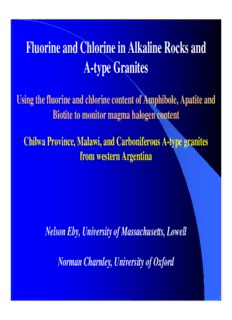
Fluorine and Chlorine in Alkaline Rocks and A-type Granites PDF
Preview Fluorine and Chlorine in Alkaline Rocks and A-type Granites
Fluorine and Chlorine in Alkaline Rocks and A-type Granites Using the fluorine and chlorine content of Amphibole, Apatite and Biotite to monitor magma halogen content Chilwa Province, Malawi, and Carboniferous A-type granites from western Argentina Nelson Eby, University of Massachusetts, Lowell Norman Charnley, University of Oxford Fluorine and Chlorine in felsic magmas • There are three common minerals that contain F and Cl – amphibole, apatite, and mica. • Titanite, a mineral that is common in some A-type granites and alkaline rocks, also contains significant amounts of F. • Models exist for calculating the F and Cl content of melts using apatite and biotite chemistry. • No model currently exists for calculating the F and Cl content of a melt using amphibole chemistry. • Variations in the F and Cl content in the various halogen containing minerals can be used to monitor changes in magma F and Cl content. Given that these minerals will form at different times during the crystallization of a magma they can provide a picture of the variation in F and Cl content of the magma with crystallization. • Electron microprobe analysis of these minerals for F and Cl is far from trivial. I will be happy to discuss our approach after the talk. Chilwa alkaline province – Location The Cretaceous age Chilwa Alkaline Province (CAP) is located in southern Malawi near the southern end of the present-day East African Rift System. Geology of the Chilwa Alkaline Province Lithologies: carbonatite, nepheline-sodalite syenite, nepheline syenite, syenite, granite Junguni Chaone & Mongolowe Zomba Major lithologies of the Chilwa Province • Metavolcanics (basanites) and olivine nephelinites • Nepheline-sodalite syenites and nepheline syenites • Syenites and alkali granites Sequence of emplacement • Lava flows (basanites) and nepheline-sodalite syenites • Nepheline syenites and syenites • Syenites and alkali granites The pattern is increasing silica content with decreasing age P19(4) – Medium grained fayalite-biotite-amphibole granite. Zomba. P19(1) – Porphyritic pyxoxene-amphibole-biotite- quartz syenite. Zomba. P20(4) – Medium grained amphibole-biotite-aegirine- nepheline syenite. Chinduzi. P21(17) – Medium- to coarse- grained amphibole-biotite- aegirine-nepheline-sodalite syenite. Chaone. Chemical composition of Chilwa biotites
Description: